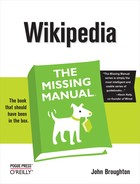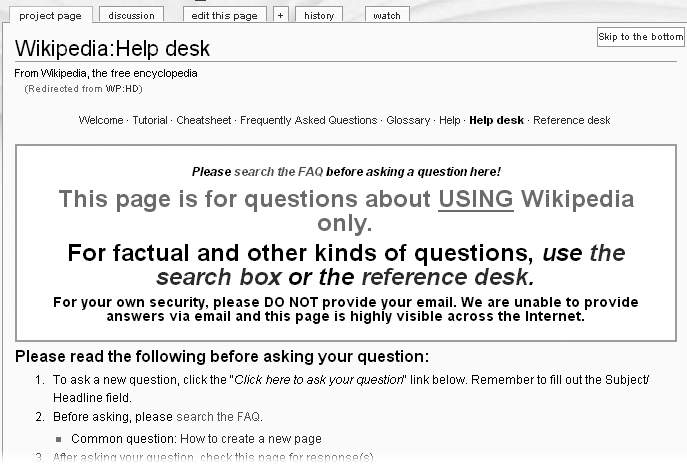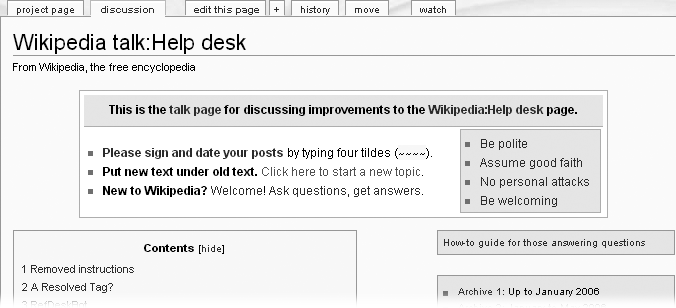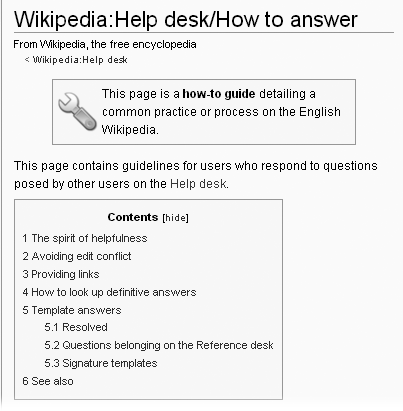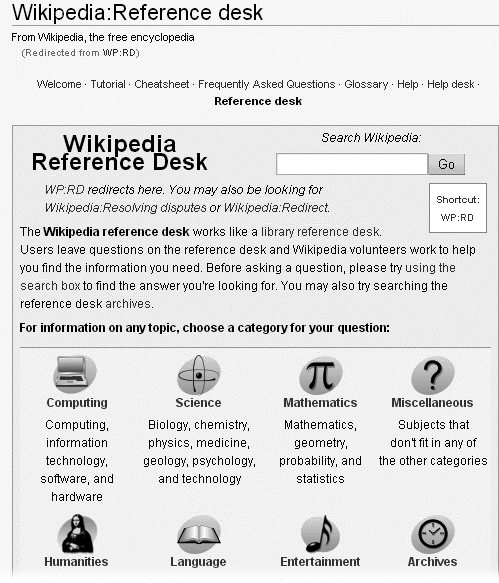Most of this book is about articles—creating, improving, arguing over, deleting. But Wikipedia is more than just a large number of articles. It’s a community of people—the editors. Wikipedia has a number of pages and activities to assist editors: to answer specific questions, to help editors learn more about good editing, to help resolve differences of opinion, and even just to show appreciation. As with everything else at Wikipedia, the people who run these pages and activities are also editors—volunteers just like you. This chapter shows you all the places and ways you can lend other editors a hand.
If you’re not an experienced editor, you may feel that it’s too soon to read this chapter. But many of the pages and activities described below don’t require a lot of experience. More importantly, you can pick and choose where you want to help. For example, if you’re looking at a page of questions by editors, you can just skip any questions that you don’t understand. Furthermore, you have one advantage that many other editors don’t—you have this book.
One of the easiest ways you can help other editors is by answering their questions. If you don’t know an answer, or don’t have the time to research an answer, you can simply leave the question for other editors to answer.
Tip
You may find answers to other editors’ questions in this book. But there’s another general resource for researching questions—the Editor’s index to Wikipedia (shortcut: WP:EIW). With more than 2,000 entries, this index probably has a link to the page or pages you need to answer most questions. You must understand the subject matter well enough to get to the right section of the index, and you may have to click through several pages to find exactly the information you need.
The main place for editors to ask general questions is the page Wikipedia:Help desk (shortcut: WP:HD). On a typical day, editors ask and answer 50 to 100 questions. This section shows you how to answer Help desk questions. You can also answer questions on other Wikipedia pages, listed at the end of this section.
To get started answering questions at the Help desk, first read the top of that page (Figure 12-1). The Help desk page starts out with a number of, er, emphatic announcements. As you can guess, a lot of folks have misunderstood the Help desk’s purpose. It’s for help using the online encyclopedia, not for help finding articles. People who are very new to Wikipedia should check the FAQ first, since the answers to their questions are probably already there. Self-help, however, doesn’t come easily to people who are completely new.
Figure 12-1. The phrase “For factual and other kinds of questions” means that the Help desk is not the place to look for information contained in encyclopedia articles. For a question like, “How long do butterflies live?” use the search box to find the article Butterfly, which probably contains the answer.
Tip
Some questions aren’t answered in articles because they’re not really encyclopedic, like, “What’s a good camera to buy for someone who wants to be a professional photographer?” Take those questions to the Reference desk (shortcut: WP:RD), which is similar to a librarian service (and another place to put your question-answering expertise to good use). See the box on Helping at the Help desk for more detail.
The top of the Help desk page contains two links to different collections of frequently asked questions (FAQs). The “Frequently Asked Questions” link near the top of Figure 12-1 goes to a set of FAQs on Wikipedia pages. The link “search the FAQ” (which appears twice) goes to an alternative, searchable compilation of FAQs called Nubio at http://tools.wikimedia.de/~tangotango/nubio/.
The Help desk also has its own talk (discussion) page (Figure 12-2). If you want to lend a hand answering questions, read the talk page to get a feel for what other volunteers have been doing and thinking for the past couple of months. If you have a question about answering questions, or you think of a way to improve the help process, bring up the issue on this talk page.
Figure 12-2. The top of the Help desk’s talk page has instructions to help you get started using the page. The links at right (“Be polite”, “Assume good faith”, and so on) link to guideline pages. These norms of conduct (Chapter 11) apply throughout Wikipedia, as well as to editors working the Help desk and posting on the talk page.
The most important link for a helpful editor like you who wants to answer questions is hidden on the talk page, in small print at that. Look on the right, just below the first box of instructions in Figure 12-2, for the box that reads, “How-to guide for those answering questions”. That page walks you through the process of answering questions from other editors (Figure 12-3): being concise, avoiding edit conflicts with other editors who are answering questions, providing links to relevant policies and guidelines, finding answers to questions about Wikipedia, and handling general knowledge questions that really belong at the Reference desk.
The Help desk gets a wide range of questions about editing every day. You can learn a lot there just by reading answers, or by researching questions yourself in order to provide answers. But it’s not the only place folks go to ask questions. If you’re looking for quieter territory—with fewer questions and fewer editors answering questions—check out the following pages:
And if that’s not enough, editors can ask questions in two more ways—two more ways that you can offer answers and help:
Editors can join the #wikipedia-en-help IRC chat room for live assistance. For more on IRC, see IRC.
Editors can post the {{Helpme}} template on their user talk pages, along with a question or request for assistance. That template automatically lists the user talk page at Category:Wikipedians looking for help (shortcut: CAT:HELP). It also sends a notice to the IRC help channel.
Editors tend to ask specialized questions (for example, about a particular policy) on the relevant talk (discussion) page, not on a consolidated help page. Still, Wikipedia has a few places for specialized questions, and thus a few places where you can consider offering advice if you’re comfortable with the particular area:
Wikipedia:Drawing board (shortcut: WP:DRAW) is a place for editors to discuss ideas they have about new articles before they create them. If you’ve read Chapter 4 of this book, you’re already qualified to help here. Some editors who post answers here have a number of standard paragraphs (opening welcome, showing notability via reliable sources, registering for an account, and links to instructional pages) that they select and modify to fit the question. Take a look at the archives to see how different editors have responded to similar questions. Don’t hesitate to borrow the wording of other editors when you see something you like.
Wikipedia:Media copyright questions (shortcut: WP:MCQ) is a place to get help with image tagging, or questions about specific images. If you want to join in answering, read Chapter 15.
Wikipedia:Village pump (technical) (shortcut: WP:VPT) is for discussing technical Wikipedia issues. More often than not, those questions are about problems, or how to do something. It’s also the Wikipedia page that developers of the MediaWiki software—which runs Wikipedia and all the other wikis of the Wikimedia Foundation (Introduction)—are most likely to read.
Wikipedia:Graphic Lab (shortcut: WP:GL) takes existing images created by other editors and improves them as requested. If you’re experienced in image manipulation and creation, this could be a fun gig to help out with.
